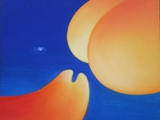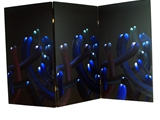Visual symphonies



































In a pluralistic world, modernity is that which fills a person's life and articulates itself through their creative activity. The question "how" has become the main celebrant of our existence and artistic-intellectual cognition. Pius Ciapało entered painting at a point after the end of art, when the motorial ideas of modernism – avant-garde and progress – had fallen into triviality and self-annihilation.
At the turn of the 1960s and 1970s, anti-art and conceptualism had already taken another turn. Pius Ciapało, riding the wave of new figuration with the inventiveness characteristic of the young artist, produced picture after picture under the common title Unlikely and Unlikely Similar Forms, with fragments of the body and figures in motion. The archaised erotic symbolism then passed into large-scale 'symphonies' and must have awakened the desire to get to the source from which the 'architectural thought' originated. Now Ciapało paints the post-conceptual structures again as if he were standing in the transition from the realm of thought to the vision materialising in the painting. Both are still undefined, because the painterly horizon turns out to be an illusion for knowledge. The idea of structure does not allow itself to be grasped, certainty slips away, and what remains are images like footprints in the sand. Although ever-changing emotional experiences and tropes universalising individual experience inspire and measure the successive stages of one's own path – the erotic imperative, studies of the construction of form, exploration of the biblical message, intellectual shock after the demolition of the WTC towers in New York – one can see how the events of lived history drive the inner development of Ciapało's work – the structure of the image and the purification of expression that colour utters.
The imperfection of the trace-painting does not discourage the painter; on the contrary, it urges him to make a new attempt. This exploration of the mystery of the creation of a painting has been going on for forty years and has not exhausted the stock of creation. Pius Ciapało once again shares his experience at the Abakus Gallery. Again, the viewer together with the author stands in the doorway between the microcosm and the macrocosm, intellect and emotion, intuition and knowledge, the experienced and the unknown. The artist surrenders himself to the public pasture in order to convey something more than aesthetic pleasure, he says, that no next point on the road brings fundamental certainty.
The structure of the crystal symphony – originally called 'analytical' because of the colour issues – is a composition of ten paintings measuring 100x80 cm, arranged in two rows of five in each. The total dimension of the structure is 200x400 cm. The colour part of the triad in the upper frieze can be distinguished, while below it there are three paintings in resultant colours (green, violet and orange), forming pairs of complementary colours with the previous ones. To the right of this colour arrangement are situated six paintings in spectral colours and two paintings-structures, one below the other, in the colours of polished metals – gold and silver.
The latter, as flat sheets of metal (planes), were cut in half crosswise and lengthwise in half and again in half, and so on, suggesting an infinite process. The chromatic part is composed in six spectral colours. The two achromatic images (white and black), on the other hand, are cut with a soft arc halfway up the longer side of each, illuminating the slit and thereby suggesting a move into space beyond the plane, but (also) alluding to the constant motif of iconographic forms used by the author in his earlier symphonies.
Ciapało borrowed the name crystal symphony from the vault of a Gothic church in Gdansk when he had his second degree qualification for the position of associate professor at the Academy of Fine Arts in that city in the winter of 1986.
Alongside other small-scale structural compositions, the exhibition also includes two compositions entitled „The Black Thing”. One was created at an open-air workshop in Grybów in the summer of 1981, when the country's affairs were seen in black by the artist (ten paintings, oil on canvas, 35x40 cm, total 70x200 cm). The second comes from the first period of martial law introduced on 13 December 1981 – it also consists of ten paintings in sizes: 65x80 cm creating a composition of 130x400 cm.
The colourful frieze situated spatially is a „Passage” in the colours of the triad, compared by the author to a musical passage: c - e - g - c - e - g - c - g - e - c (do - mi - sol - do - mi - sol - do - sol - mi - do - sol - mi - do - sol - mi - do), perhaps reminiscent of a church organ in exposure.
At the turn of the 1960s and 1970s, anti-art and conceptualism had already taken another turn. Pius Ciapało, riding the wave of new figuration with the inventiveness characteristic of the young artist, produced picture after picture under the common title Unlikely and Unlikely Similar Forms, with fragments of the body and figures in motion. The archaised erotic symbolism then passed into large-scale 'symphonies' and must have awakened the desire to get to the source from which the 'architectural thought' originated. Now Ciapało paints the post-conceptual structures again as if he were standing in the transition from the realm of thought to the vision materialising in the painting. Both are still undefined, because the painterly horizon turns out to be an illusion for knowledge. The idea of structure does not allow itself to be grasped, certainty slips away, and what remains are images like footprints in the sand. Although ever-changing emotional experiences and tropes universalising individual experience inspire and measure the successive stages of one's own path – the erotic imperative, studies of the construction of form, exploration of the biblical message, intellectual shock after the demolition of the WTC towers in New York – one can see how the events of lived history drive the inner development of Ciapało's work – the structure of the image and the purification of expression that colour utters.
The imperfection of the trace-painting does not discourage the painter; on the contrary, it urges him to make a new attempt. This exploration of the mystery of the creation of a painting has been going on for forty years and has not exhausted the stock of creation. Pius Ciapało once again shares his experience at the Abakus Gallery. Again, the viewer together with the author stands in the doorway between the microcosm and the macrocosm, intellect and emotion, intuition and knowledge, the experienced and the unknown. The artist surrenders himself to the public pasture in order to convey something more than aesthetic pleasure, he says, that no next point on the road brings fundamental certainty.
The structure of the crystal symphony – originally called 'analytical' because of the colour issues – is a composition of ten paintings measuring 100x80 cm, arranged in two rows of five in each. The total dimension of the structure is 200x400 cm. The colour part of the triad in the upper frieze can be distinguished, while below it there are three paintings in resultant colours (green, violet and orange), forming pairs of complementary colours with the previous ones. To the right of this colour arrangement are situated six paintings in spectral colours and two paintings-structures, one below the other, in the colours of polished metals – gold and silver.
The latter, as flat sheets of metal (planes), were cut in half crosswise and lengthwise in half and again in half, and so on, suggesting an infinite process. The chromatic part is composed in six spectral colours. The two achromatic images (white and black), on the other hand, are cut with a soft arc halfway up the longer side of each, illuminating the slit and thereby suggesting a move into space beyond the plane, but (also) alluding to the constant motif of iconographic forms used by the author in his earlier symphonies.
Ciapało borrowed the name crystal symphony from the vault of a Gothic church in Gdansk when he had his second degree qualification for the position of associate professor at the Academy of Fine Arts in that city in the winter of 1986.
Alongside other small-scale structural compositions, the exhibition also includes two compositions entitled „The Black Thing”. One was created at an open-air workshop in Grybów in the summer of 1981, when the country's affairs were seen in black by the artist (ten paintings, oil on canvas, 35x40 cm, total 70x200 cm). The second comes from the first period of martial law introduced on 13 December 1981 – it also consists of ten paintings in sizes: 65x80 cm creating a composition of 130x400 cm.
The colourful frieze situated spatially is a „Passage” in the colours of the triad, compared by the author to a musical passage: c - e - g - c - e - g - c - g - e - c (do - mi - sol - do - mi - sol - do - sol - mi - do - sol - mi - do - sol - mi - do), perhaps reminiscent of a church organ in exposure.